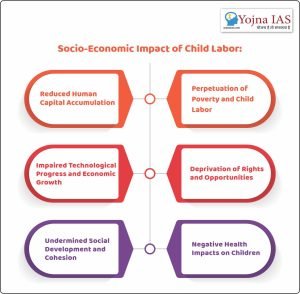01 Aug 2023 Child Labour
This article covers “Daily Current Affairs” and the topic details “Child Labour”. The topic “Child Labour” has relevance in the Social Justice section of the UPSC CSE exam.
For Prelims:
About Child Labour?
Status of Child Labor in India?
For Mains:
GS 2: Social Justice
Government Initiatives to Curb Child Labor in India?
Way Forward?
Why in the news:
In a recent development, the National Human Rights Commission (NHRC) has taken action by issuing a notice to 13 states, which includes Uttar Pradesh. The commission has urged the state governments to play a more proactive role in identifying and rescuing bonded child laborers.
Definition of Child Labor:
- Child labor refers to the exploitation of children by engaging them in work that deprives them of their childhood, potential, and dignity.
- Child labor can take various forms, including domestic work, agriculture, factories, mines, construction, and informal sectors.
Child Domestic Labour:
- Child domestic work pertains to the involvement of children in performing domestic tasks within the residence of a third party or employer.
- It involves children performing household chores, caregiving, cooking, cleaning, and other domestic tasks for remuneration or in exploitative conditions.
Hazards of Child Domestic Work:
- Long and tiring working days.
- Exposure to toxic chemicals.
- Carrying heavy loads.
- Handling dangerous items like knives and hot pans.
- Insufficient or inadequate food and accommodation.
- Vulnerability to physical and emotional abuse.
- Isolation and lack of social interaction.
Status of Child Labor in India:
- According to data from the National Crime Records Bureau Report in 2022, approximately 982 cases were registered under the Child Labour (Prohibition and Regulation) Act of 1986 in India during the year 2021.Telangana and Assam reported the highest number of cases.
- The Covid-19 pandemic and closure of schools have led to a significant increase in the proportion of working children, particularly in states like Uttar Pradesh, Bihar, Rajasthan, Madhya Pradesh, and Maharashtra.
Causes of Child Labor in Domestic Work in India:
- Social and Economic Conditions: Impoverished families often rely on child labor to supplement their income due to inadequate wages for adult workers.
- Cultural Norms: In certain communities, child labor in domestic work is a traditional practice, and education may not be considered important, especially for girls.
- Migration: Vulnerable communities, like tribals and Dalits, migrating to urban areas face increased risks of child labor in domestic work due to limited opportunities.
- Lack of Access to Education: Poor school infrastructure and associated costs discourage parents from sending their children to school.

Government Initiatives to Curb Child Labor in India:

Way Forward:
- Strengthening and Implementing Laws: Enact and amend laws to prohibit and regulate child labor, in line with international standards and conventions.
- Ensuring Access to Education: Ensure free and compulsory education for all children up to 14 years of age to reduce the need for child labor as a coping mechanism.
- Social Protection and Economic Support: Provide comprehensive support to poor and vulnerable families to prevent them from resorting to child labor.
- Awareness and Enforcement: Raise awareness about the harms of child labor and enforce laws effectively to deter employers from engaging children in exploitative work.
Q.1 ACT : Year of enactment
- Right to Education Act : 2009
- Child Labour (Prohibition and Regulation) Act : 1986
- The Factories Act : 1948
- National Policy on Child Labour : 1987
How many of the above pairs is/are correct?
(a) One only
(b) Two only
(c) Three only
(d) All Four
Answer: (d)
Q.2 Assertion (A) : Child labour is a prevelant problem in India.
Reason (R) : India Lacks a comprehensive law on prevention of Child Labour
Select the correct answer from the options below:
(a) if both A and R are true and R is the correct explanation of A
(b) if both A and R are true but R is not the correct explanation of A
(c) if A is true but R is false
(d) if A is false but R is true
Answer: (c)
Q.3 Examine the challenges faced in eradicating this problem and suggest comprehensive policy measures to ensure the effective elimination of child labor and protect the rights and well-being of children engaged in domestic work


No Comments